 Facebook
Facebook
 X
X
 Instagram
Instagram
 TikTok
TikTok
 Youtube
Youtube
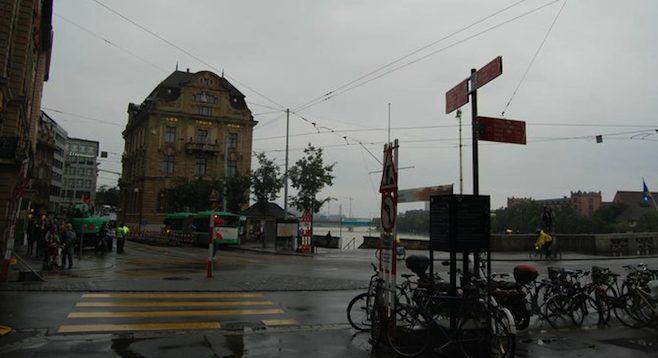
Behind Basel, Switzerland’s bourgeois persona is a mind-blowing history currently experiencing its 70th anniversary.
Inside the walled-off compound where multinational pharmaceutical giant Novartis (formed when Ciba-Geigy and Sandoz merged) is headquartered is a futuristic glassy-steel building designed by architect Frank Gehry, who created L.A.’s curvy Disney Concert Hall.
Rudie Suter, my guide who specializes in Basel’s modern architecture, points into the distance, telling me that on April 16, 1943, in one of the less ostentatious structures, Sandoz chemist Albert Hofmann accidentally dosed himself with Lyserg-saure-diathylamid – or LSD – which he’d synthesized in 1938.
Three days later, on what’s now called “Bicycle Day,” Hofmann deliberately dropped 250 micrograms of the psychoactive substance, rode home on a bike and experienced “altered perceptions” amidst a “spontaneous visionary experience”:
According to Hofmann’s book, LSD – My Problem Child, the following morning he awoke feeling:
While the rest of Europe was at war, in this neutral Swiss city wedged on the Rhine between occupied France and Nazi Germany, Hofmann – who’d been trying to build a better aspirin – got more than he bargained for.
Near the Big Pharma campus I spied a yellow car that seemed to lurk down a side street. Rudi explained it was a “drug relief” vehicle, deployed not to bust users – as one would expect in Drug War America – but, astonishingly, to provide addicts with clean syringes to ensure hygiene. How appropriate for acid’s birthplace!
Beneath Basel’s stuffy surface lies a psychedelic sensibility and higher consciousness. Psychologist and “collective unconscious” symbologist C.G. Jung spent part of his childhood there. Dadaist Jean Tinguely, sculptor of pure flights of fancy, grew up there.
Switzerland’s third-most populous city is an intellectual and arts center, home to: The oldest Swiss university. Theater Basel, a top venue for plays, operas and ballets. Museums. The Alpine nation’s largest Mardi Gras-like carnival, Basel Fasnacht, with mind-bending costumes and uninhibited merriment.
Indeed, Basel Tourism’s official motto is “culture unlimited.”
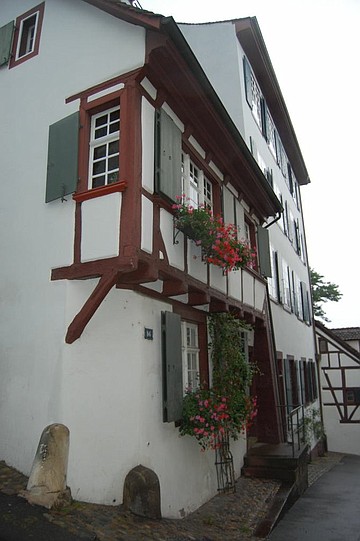
On another tour, guide Annelies Bachle notes Basel’s traditions go back 500+ years to the Renaissance. Circa 1509, botanist, humanist and astrologist Paracelsus studied and taught medicine at the University of Basel, established in 1460. Just as Hofmann sought to relieve headaches, Paracelsus created laudanum, a psychotropic for easing bodily pain.
A Pharmaceutical Historical Museum now exists in the former home of a prominent printer whose physician was Paracelsus. Dutch Enlightenment thinker Erasmus also lived in this house with its spacious courtyard, where elixirs, herbariums, remedies, et al are now displayed.
As aromatic as Basel’s name sounds, however, it’s not named after the herb, but derived from the word for “kingship” in Latin and ancient Greek.
Annelies leads me through Old Town’s narrow winding cobblestone streets, with Middle-Aged half-timbered buildings above the Rhine.
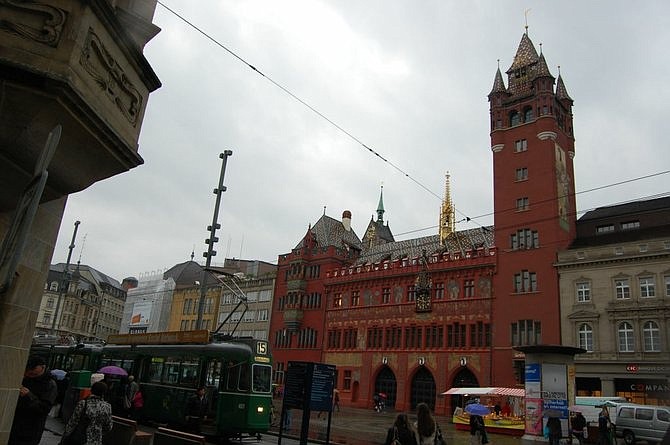
A fountain is topped by the statue of a hat-and-jacket clad monkey eating grapes near an outdoor cafe. Businesses use traditional signs with iron images designed by medieval “Mad Men” to advertise their purposes, such as the Schnabel Restaurant. Trams whisk passengers past the ornate reddish Rathaus (left) with its large clock, painted façade and wooden window shutters designed with Vasarely-like op-art. Basel’s municipal building was first established near this marketplace site in the 14th century, looking to untutored eyes like a mini-Kremlin.
Statues of St. George slaying a dragon with a lance adorn a red sandstone wall of the Münster, elevated on a hillside overlooking the Rhine. There, Annelies deciphers the medieval symbology’s religious significance. Another statue on the cathedral’s exterior wall depicts St. Martin rending his garment to share it with a beggar, while grotty gargoyles serve the dual function of funneling rainwater and warding off evil spirits.
Amidst brilliantly hued stained glass windows are tombs inside the church and courtyard, including a stony statue of Heinrich V in repose in full body armor, a sword beside him, a lion at his mail sabaton-clad feet. The emperor at the center of 1122’s Concordat of Worms had become meat for worms ages ago.
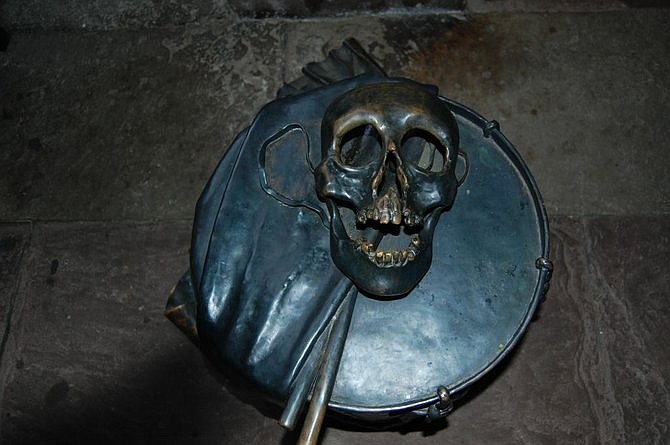
This plus a bronze skull atop a drum remind worshippers of man’s mortality (left), as does another gigantic clock above St. Martin’s statue, ticking our minutes away. The Münster’s twin towers, originally consecrated in 1019, are almost 1,000 years old.
I explored LSD’s hometown by foot and tram – not by bicycle. Nevertheless, I could “picture myself in a boat on a river,” cruising the Rhine for three hours aboard a Basler Personenschiffahrt. I did not see “a girl with kaleidoscope eyes,” “cellophane flowers,” “tangerine trees and marmalade skies,” but I ate sumptuous breakfast quickly followed by lunch buffet on this Sunday brunch voyage.
The cruise began with something as dazzling as "Lucy in the Sky With Diamonds," floating through Basel’s glorious Old Town and, momentarily, back in time before the sound and fury of our high-tech era. After the boat turns about and heads down the Rhine, past Germany and France, we pass cottages poised along riverbanks with long fishing rods and nets.
The boat departs from a pier below the staid, stately Les Trois Rois. A guesthouse as far back as 1641, it reopened as a Grand Hotel in 1844 in the midst of Basel’s picturesque medieval village. It remains a splendid five-star, a repository of elegance situated directly above the Rhine near Mittlere Brücke (Central Bridge) – the oldest existing crossing over the Rhine (below) between Lake Constance and the North Sea. The bridge's origins date back to 1225, although it was rebuilt over the ages.
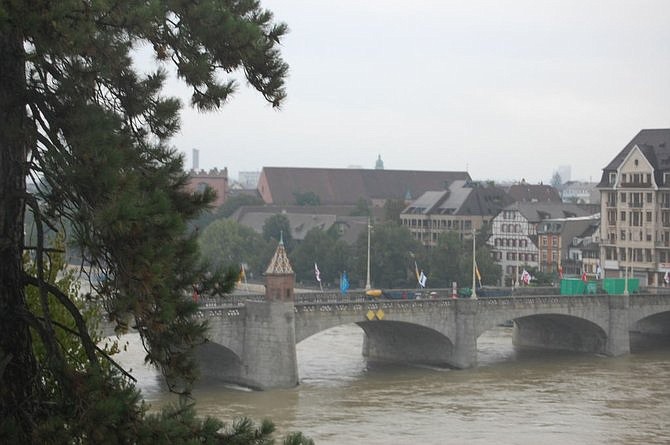
Les Trois Rois guests enjoy exquisite views of Basel’s most beautiful quarter from Le Brasserie and their rooms, as well as of the river, where hardy summer swimmers, many using Rhein-Schwimm-Säcke (Rhine-swimming-bags), drift downstream on the currents.
The Grand Hotel’s well-appointed interiors are also peerless, with a crystal chandelier hanging above the lobby and tastefully traditional luxurious units with balconies above the Rhine’s rushing ripples. The service ranged from helpful concierges to snooty waiters to camera-shy staffers in colorful 19th-century costumes.
Overlooking cornfields, beside Monet-like ponds, Fondation Beyeler showcases the private modern art collections of two late dealers. When I visited, Jeff Koons’ floral, wood, porcelain, canvas, balloon creations were displayed; Dadaist Max Ernst’s work will be exhibited May 6-Sept. 8.
On an earlier excursion to Kunstmuseum Basel, I experienced an exhilarating Van Gogh exhibition. A Picasso retrospective is underway through July 21. Basel is presenting jazz and blues festivals April through June.
Spine-tingling Museum Tinguely is another architectural gem designed by Swiss architect Mario Botta, situated between the Rhine and Solitude Park. The eponymous artist’s outlandish, phantasmagorical, machine-like moving sculptures are kids’ favorites. Children of all ages step on buttons to activate the kinetic statuary, causing cogs to whir, wheels to spin, music to play, all to no purpose other than to delight. Call these “metamatics” – the Industrial Revolution still lives. During my visit, the oil, theater design and sculptural art of Soviet revolutionary Vladimir Tatlin was highlighted in a special exhibit.
Outdoor installations (“out-stallations”?) of Tinguely’s oeuvre can be seen at Basel’s Theaterplatz, where “Carnival Fountain” sprinkles art lovers.
Basel’s Children’s Hospital’s eye-catching exterior literally changes colors, from pumpkin orange to lime green. Bathed in a psychedelic Purple Owsley glow, it’s so apropos for LSD’s hometown. I turned on and tuned in while I dropped out; taking in Basel’s razzle-dazzle, my trip naturally expanded my mind, taking me beyond the doors of perception.
Visiting Switzerland? The concert “LSD – Lucid Sound Dreams,” dedicated to Albert Hofmann and performed by Camerata Variabile Basel, will take place at Gare du Nord (Basel’s railway station), April 18 at 8:00 p.m.


Behind Basel, Switzerland’s bourgeois persona is a mind-blowing history currently experiencing its 70th anniversary.
Inside the walled-off compound where multinational pharmaceutical giant Novartis (formed when Ciba-Geigy and Sandoz merged) is headquartered is a futuristic glassy-steel building designed by architect Frank Gehry, who created L.A.’s curvy Disney Concert Hall.
Rudie Suter, my guide who specializes in Basel’s modern architecture, points into the distance, telling me that on April 16, 1943, in one of the less ostentatious structures, Sandoz chemist Albert Hofmann accidentally dosed himself with Lyserg-saure-diathylamid – or LSD – which he’d synthesized in 1938.
Three days later, on what’s now called “Bicycle Day,” Hofmann deliberately dropped 250 micrograms of the psychoactive substance, rode home on a bike and experienced “altered perceptions” amidst a “spontaneous visionary experience”:
According to Hofmann’s book, LSD – My Problem Child, the following morning he awoke feeling:
While the rest of Europe was at war, in this neutral Swiss city wedged on the Rhine between occupied France and Nazi Germany, Hofmann – who’d been trying to build a better aspirin – got more than he bargained for.
Near the Big Pharma campus I spied a yellow car that seemed to lurk down a side street. Rudi explained it was a “drug relief” vehicle, deployed not to bust users – as one would expect in Drug War America – but, astonishingly, to provide addicts with clean syringes to ensure hygiene. How appropriate for acid’s birthplace!
Beneath Basel’s stuffy surface lies a psychedelic sensibility and higher consciousness. Psychologist and “collective unconscious” symbologist C.G. Jung spent part of his childhood there. Dadaist Jean Tinguely, sculptor of pure flights of fancy, grew up there.
Switzerland’s third-most populous city is an intellectual and arts center, home to: The oldest Swiss university. Theater Basel, a top venue for plays, operas and ballets. Museums. The Alpine nation’s largest Mardi Gras-like carnival, Basel Fasnacht, with mind-bending costumes and uninhibited merriment.
Indeed, Basel Tourism’s official motto is “culture unlimited.”

On another tour, guide Annelies Bachle notes Basel’s traditions go back 500+ years to the Renaissance. Circa 1509, botanist, humanist and astrologist Paracelsus studied and taught medicine at the University of Basel, established in 1460. Just as Hofmann sought to relieve headaches, Paracelsus created laudanum, a psychotropic for easing bodily pain.
A Pharmaceutical Historical Museum now exists in the former home of a prominent printer whose physician was Paracelsus. Dutch Enlightenment thinker Erasmus also lived in this house with its spacious courtyard, where elixirs, herbariums, remedies, et al are now displayed.
As aromatic as Basel’s name sounds, however, it’s not named after the herb, but derived from the word for “kingship” in Latin and ancient Greek.
Annelies leads me through Old Town’s narrow winding cobblestone streets, with Middle-Aged half-timbered buildings above the Rhine.

A fountain is topped by the statue of a hat-and-jacket clad monkey eating grapes near an outdoor cafe. Businesses use traditional signs with iron images designed by medieval “Mad Men” to advertise their purposes, such as the Schnabel Restaurant. Trams whisk passengers past the ornate reddish Rathaus (left) with its large clock, painted façade and wooden window shutters designed with Vasarely-like op-art. Basel’s municipal building was first established near this marketplace site in the 14th century, looking to untutored eyes like a mini-Kremlin.
Statues of St. George slaying a dragon with a lance adorn a red sandstone wall of the Münster, elevated on a hillside overlooking the Rhine. There, Annelies deciphers the medieval symbology’s religious significance. Another statue on the cathedral’s exterior wall depicts St. Martin rending his garment to share it with a beggar, while grotty gargoyles serve the dual function of funneling rainwater and warding off evil spirits.
Amidst brilliantly hued stained glass windows are tombs inside the church and courtyard, including a stony statue of Heinrich V in repose in full body armor, a sword beside him, a lion at his mail sabaton-clad feet. The emperor at the center of 1122’s Concordat of Worms had become meat for worms ages ago.

This plus a bronze skull atop a drum remind worshippers of man’s mortality (left), as does another gigantic clock above St. Martin’s statue, ticking our minutes away. The Münster’s twin towers, originally consecrated in 1019, are almost 1,000 years old.
I explored LSD’s hometown by foot and tram – not by bicycle. Nevertheless, I could “picture myself in a boat on a river,” cruising the Rhine for three hours aboard a Basler Personenschiffahrt. I did not see “a girl with kaleidoscope eyes,” “cellophane flowers,” “tangerine trees and marmalade skies,” but I ate sumptuous breakfast quickly followed by lunch buffet on this Sunday brunch voyage.
The cruise began with something as dazzling as "Lucy in the Sky With Diamonds," floating through Basel’s glorious Old Town and, momentarily, back in time before the sound and fury of our high-tech era. After the boat turns about and heads down the Rhine, past Germany and France, we pass cottages poised along riverbanks with long fishing rods and nets.
The boat departs from a pier below the staid, stately Les Trois Rois. A guesthouse as far back as 1641, it reopened as a Grand Hotel in 1844 in the midst of Basel’s picturesque medieval village. It remains a splendid five-star, a repository of elegance situated directly above the Rhine near Mittlere Brücke (Central Bridge) – the oldest existing crossing over the Rhine (below) between Lake Constance and the North Sea. The bridge's origins date back to 1225, although it was rebuilt over the ages.

Les Trois Rois guests enjoy exquisite views of Basel’s most beautiful quarter from Le Brasserie and their rooms, as well as of the river, where hardy summer swimmers, many using Rhein-Schwimm-Säcke (Rhine-swimming-bags), drift downstream on the currents.
The Grand Hotel’s well-appointed interiors are also peerless, with a crystal chandelier hanging above the lobby and tastefully traditional luxurious units with balconies above the Rhine’s rushing ripples. The service ranged from helpful concierges to snooty waiters to camera-shy staffers in colorful 19th-century costumes.
Overlooking cornfields, beside Monet-like ponds, Fondation Beyeler showcases the private modern art collections of two late dealers. When I visited, Jeff Koons’ floral, wood, porcelain, canvas, balloon creations were displayed; Dadaist Max Ernst’s work will be exhibited May 6-Sept. 8.
On an earlier excursion to Kunstmuseum Basel, I experienced an exhilarating Van Gogh exhibition. A Picasso retrospective is underway through July 21. Basel is presenting jazz and blues festivals April through June.
Spine-tingling Museum Tinguely is another architectural gem designed by Swiss architect Mario Botta, situated between the Rhine and Solitude Park. The eponymous artist’s outlandish, phantasmagorical, machine-like moving sculptures are kids’ favorites. Children of all ages step on buttons to activate the kinetic statuary, causing cogs to whir, wheels to spin, music to play, all to no purpose other than to delight. Call these “metamatics” – the Industrial Revolution still lives. During my visit, the oil, theater design and sculptural art of Soviet revolutionary Vladimir Tatlin was highlighted in a special exhibit.
Outdoor installations (“out-stallations”?) of Tinguely’s oeuvre can be seen at Basel’s Theaterplatz, where “Carnival Fountain” sprinkles art lovers.
Basel’s Children’s Hospital’s eye-catching exterior literally changes colors, from pumpkin orange to lime green. Bathed in a psychedelic Purple Owsley glow, it’s so apropos for LSD’s hometown. I turned on and tuned in while I dropped out; taking in Basel’s razzle-dazzle, my trip naturally expanded my mind, taking me beyond the doors of perception.
Visiting Switzerland? The concert “LSD – Lucid Sound Dreams,” dedicated to Albert Hofmann and performed by Camerata Variabile Basel, will take place at Gare du Nord (Basel’s railway station), April 18 at 8:00 p.m.
Comments